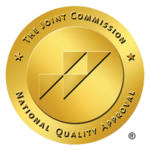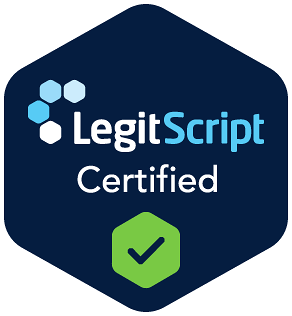Understanding addiction recovery requires looking beyond surface-level changes to see the complex healing process underneath. The journey involves rewiring brain chemistry, rebuilding relationships, and developing new coping strategies.
We at Amity Palm Beach see firsthand how proper knowledge transforms recovery outcomes. When families and individuals grasp what recovery truly entails, they make better treatment decisions and maintain long-term sobriety more successfully.
What Does Recovery Actually Look Like
Recovery from addiction unfolds through three distinct phases that span months and years, not weeks. The physical detoxification process typically lasts 7-14 days for most substances, though alcohol and benzodiazepine withdrawal can extend to 30 days with proper medical supervision. During this phase, your body eliminates toxins while it manages withdrawal symptoms like nausea, tremors, and sleep disturbances. The brain begins to produce natural neurotransmitters again, but this restoration requires time as addiction is a learned behavior that develops through repeated exposure.
Mental Transformation Takes Time
The psychological phase spans 6-18 months and requires active participation in addiction treatment. Cognitive behavioral therapy sessions twice weekly help rewire thought patterns that trigger substance use. Most people experience mood swings, anxiety, and depression during months 2-6 as their brain chemistry stabilizes. Group therapy sessions provide accountability and reduce isolation, with studies showing significant effects on abstinence compared to individual therapy alone.
Physical Recovery Milestones
Your body follows predictable patterns as it heals from substance abuse. Sleep cycles normalize within 30-60 days, though some people need up to four months for complete restoration. Energy levels increase dramatically after the first 90 days, with most clients reporting they feel more alert and focused than they have in years. Appetite returns to normal patterns within 2-3 weeks, and many people gain healthy weight during early recovery.
Lifestyle Changes Define Long-term Success
Maintenance requires permanent lifestyle modifications that support sobriety. This includes new daily routines, different social circles, and healthy coping mechanisms. The National Institute on Drug Abuse reports that people who maintain recovery for 12 months have a 70% chance of staying sober long-term. Exercise programs, meditation practice, and regular therapy sessions become non-negotiable parts of daily life. Sleep quality improves dramatically after 6-12 months, with most people who report 2-3 hours more quality sleep per night compared to active addiction periods.
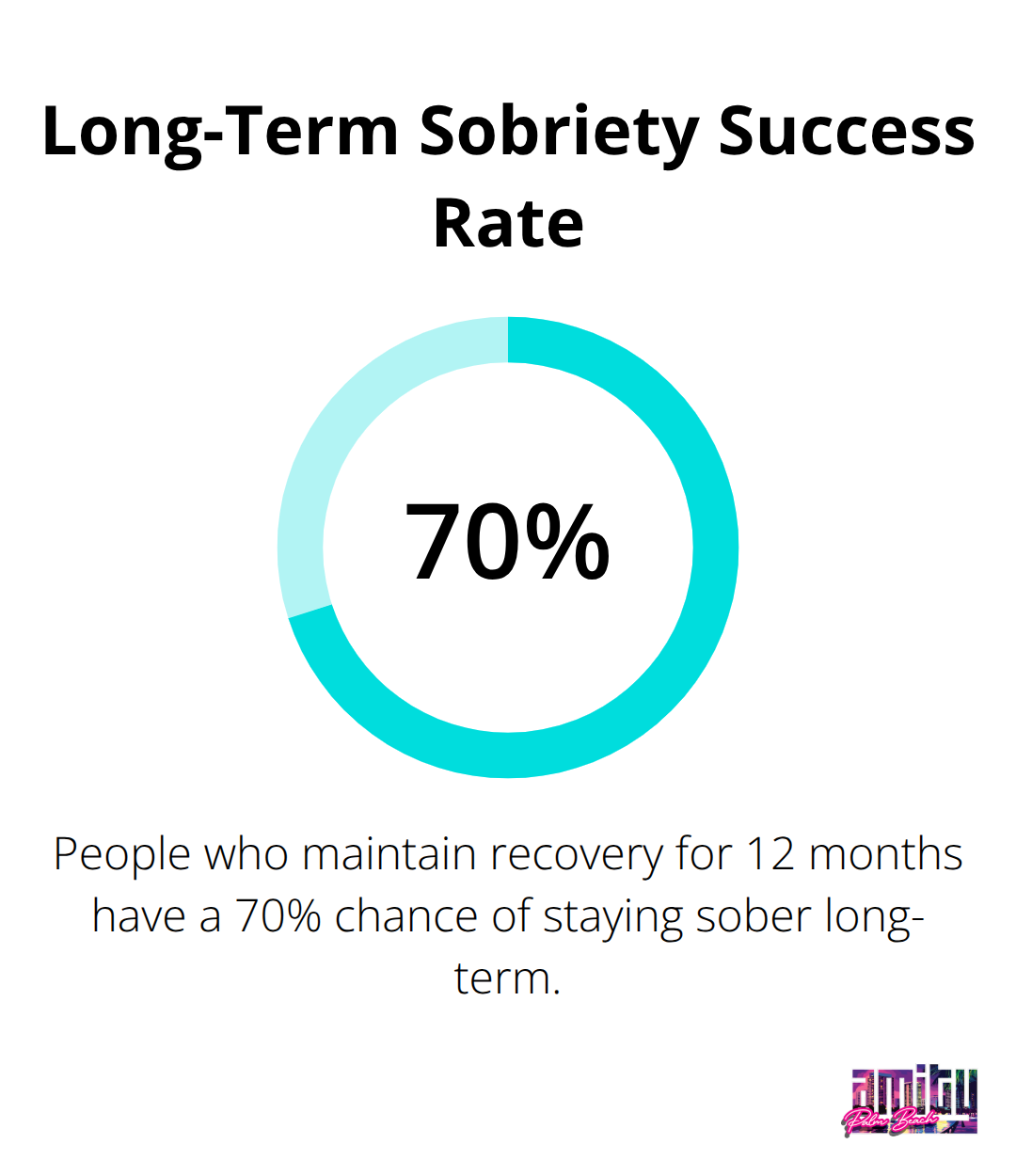
These physical and mental changes create the foundation for recovery, but the brain itself undergoes even more complex transformations that science has only recently begun to understand.
How Your Brain Actually Heals
Addiction rewires three specific brain regions that control reward, stress response, and decision-making. The basal ganglia becomes overactive during substance use and floods your system with dopamine increases that hijack your brain’s reward system. This hijack explains why people choose drugs over basic survival needs. The extended amygdala grows hypersensitive and makes normal stress feel unbearable without substances. Meanwhile, the prefrontal cortex weakens and reduces impulse control during active addiction.
Recovery Reverses Brain Damage Over Time
Your brain begins to heal within days of stopping substance use, but complete restoration takes 12-18 months of consistent sobriety. Dopamine receptors start to regenerate after 30 days, though they need 6-12 months to reach normal sensitivity levels. The prefrontal cortex strengthens gradually as you practice new decision-making patterns. Sleep cycles normalize first (within 60 days), followed by emotional regulation improvements around month 4-6.
Evidence-Based Treatments Target Specific Brain Functions
Cognitive behavioral therapy strengthens prefrontal cortex connections through repeated practice of new thought patterns. Studies show CBT reduces relapse rates compared to control groups when combined with comprehensive treatment approaches. Motivational interviewing activates the brain’s motivation centers and increases treatment engagement compared to traditional counseling approaches. These therapies work because they create new neural pathways that compete with addiction-related brain circuits.
Medication-Assisted Treatment Normalizes Brain Chemistry
MAT using buprenorphine or methadone stabilizes brain chemistry while people learn coping skills. Research shows MAT reduces overdose deaths significantly and increases treatment retention rates substantially. These medications don’t replace one addiction with another-they restore normal brain function so therapy can be effective. Single-method treatments have higher failure rates within the first year, which explains why comprehensive approaches work better.
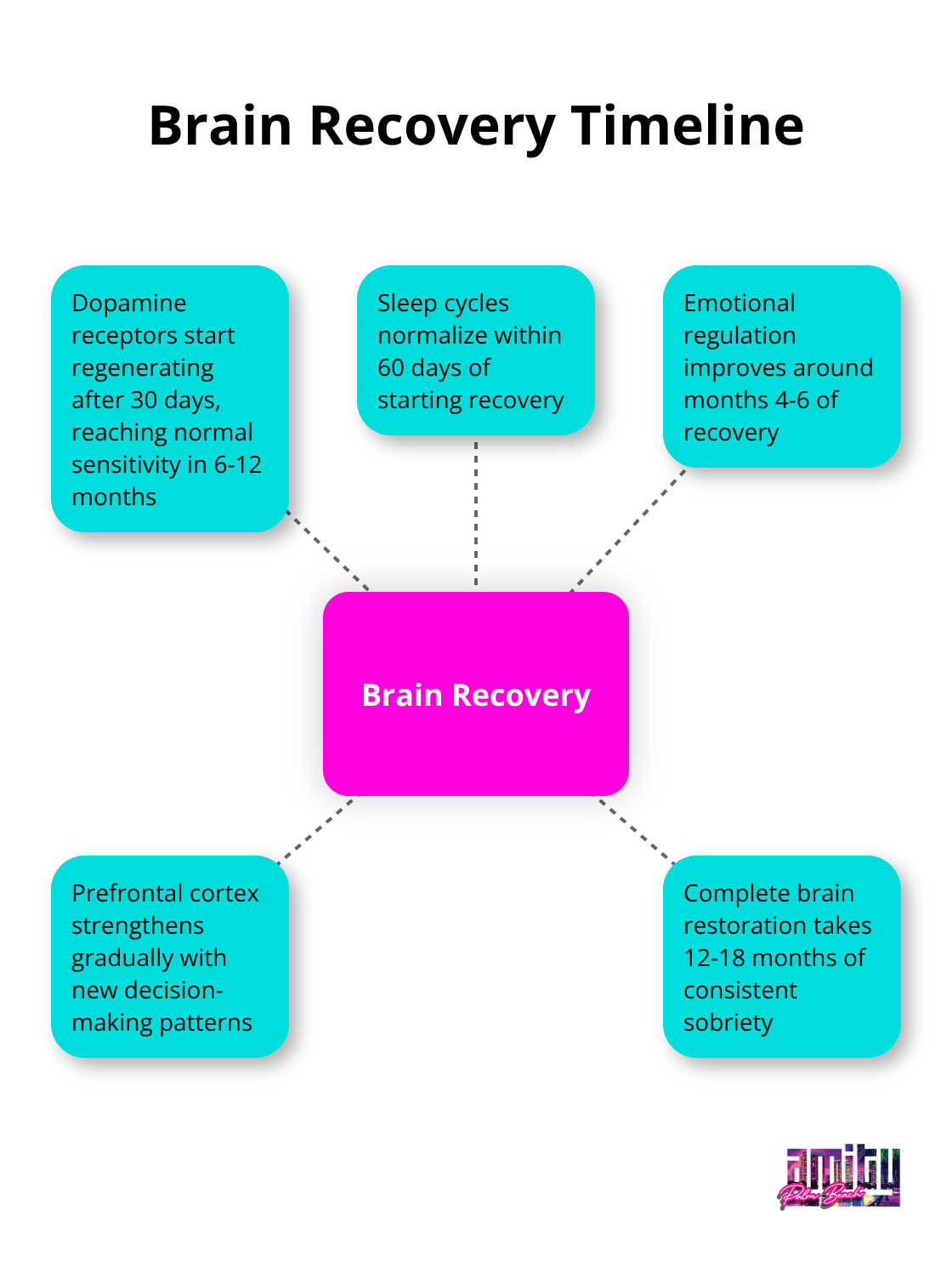
While your brain heals from addiction’s damage, you’ll face practical challenges that test your commitment to recovery every single day. Specialized neurofeedback programs can help address brain healing during this critical period, and professional addiction treatment provides the comprehensive support needed for lasting recovery.
What Recovery Challenges Actually Feel Like
Withdrawal symptoms hit hardest during your first 72 hours and can last up to 30 days depending on the substance. Alcohol withdrawal causes tremors, sweating, and potentially dangerous seizures that require medical supervision. Opioid withdrawal brings muscle aches, nausea, and severe anxiety that peaks around day 3-4. Medical supervision during detox significantly reduces complications compared to attempting withdrawal alone.
Cravings Strike Without Warning
Cravings follow unpredictable patterns and can strike months into recovery when triggered by stress, specific locations, or even certain smells. Most people experience their strongest cravings between weeks 2-8 of sobriety, when brain chemistry remains unstable. These intense urges can last anywhere from minutes to hours, and they often catch people off guard during routine activities.
Your brain associates certain environments with past substance use, which explains why walking past an old bar or seeing drug paraphernalia can trigger immediate physical responses. Stress hormones like cortisol spike during these moments, creating the same fight-or-flight response your body experienced during active addiction.
Trust Requires Concrete Actions Over Time
Your relationships suffered real damage during active addiction, and apologies alone won’t repair them. Family members need to see consistent behavior changes over 6-12 months before they start to trust again. Start with small commitments you can actually keep, like showing up on time or calling when you say you will.
Family therapy participation can increase long-term recovery success rates. Avoid making grand promises about the future and focus on daily actions that demonstrate reliability. Your loved ones have been hurt repeatedly, so they’ll test your commitment through skepticism and boundary-setting (which is actually healthy for everyone involved).
Relapse Prevention Demands Daily Structure
Relapse rates for substance use disorders mirror those of other chronic conditions, with many people experiencing at least one relapse. The highest risk periods occur during major life transitions, relationship conflicts, or when you abandon your recovery routine.
Build non-negotiable daily habits that include morning meditation, regular meal times, and consistent sleep schedules. Attend support group meetings even when you don’t feel like it, especially during your first year. Professional addiction treatment programs provide structured environments that help establish these crucial routines. Keep a written list of three people you can call immediately when cravings hit, and practice healthy coping skills before you need them in crisis situations (because panic makes it harder to remember what works).
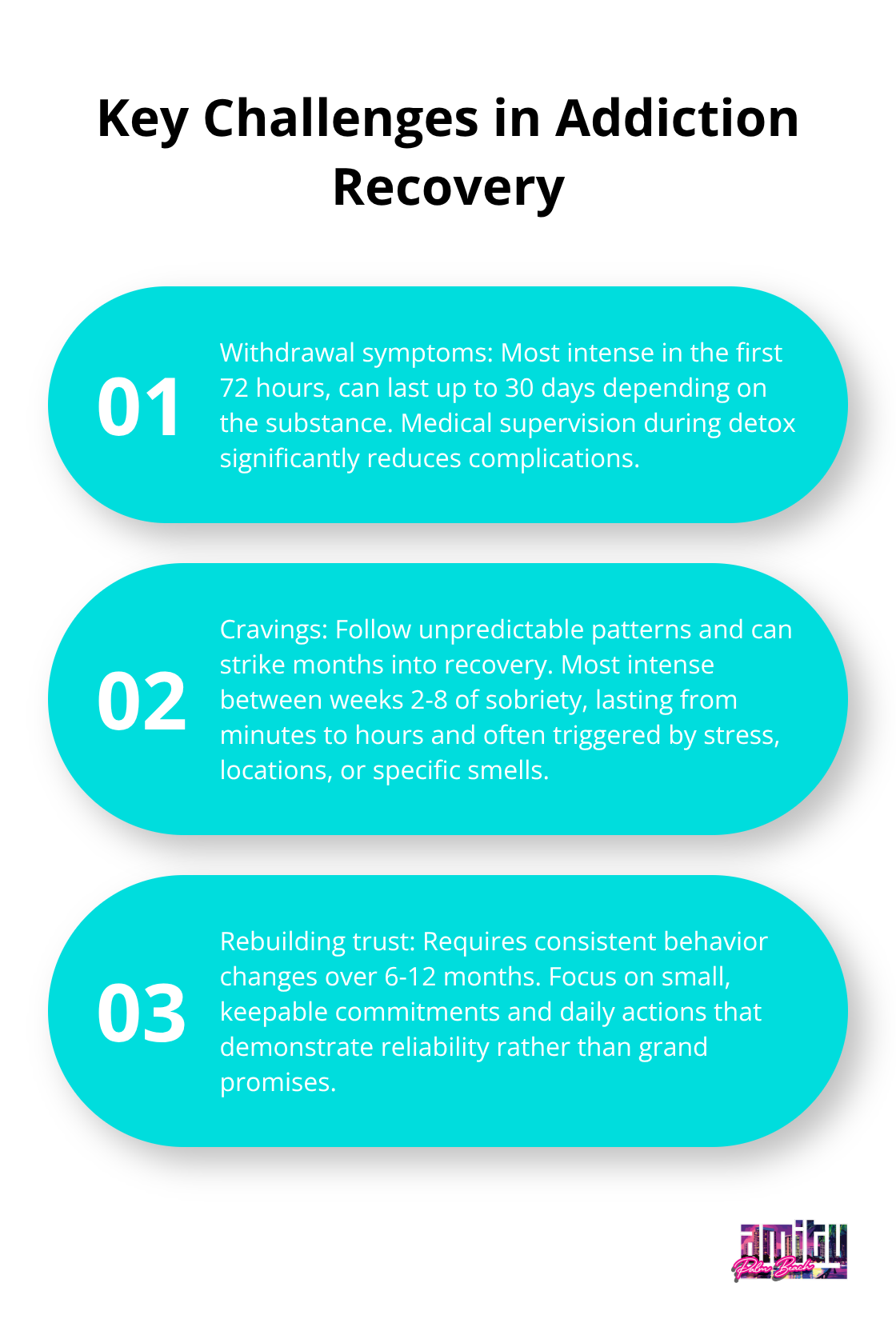
Final Thoughts
Understanding addiction recovery means you accept that healing extends far beyond initial treatment. The brain requires 12-18 months to restore normal function, while relationships need consistent actions over time to rebuild trust. Recovery success rates increase dramatically when people commit to long-term support systems and evidence-based treatment approaches.
Professional treatment programs provide the structured environment and medical supervision needed during the most vulnerable phases of recovery. We at Amity Palm Beach combine medically supervised detox with comprehensive residential programs that address both addiction and co-occurring mental health conditions. Our approach recognizes that lasting recovery requires treatment of the whole person, not just the addiction.
The statistics speak clearly: people who complete professional treatment programs and maintain ongoing support have significantly higher success rates than those who attempt recovery alone (compared to self-directed approaches). Amity Palm Beach offers clinical excellence and personalized care that transforms recovery outcomes. Recovery remains possible for everyone who commits to the process and accepts professional help when needed.



